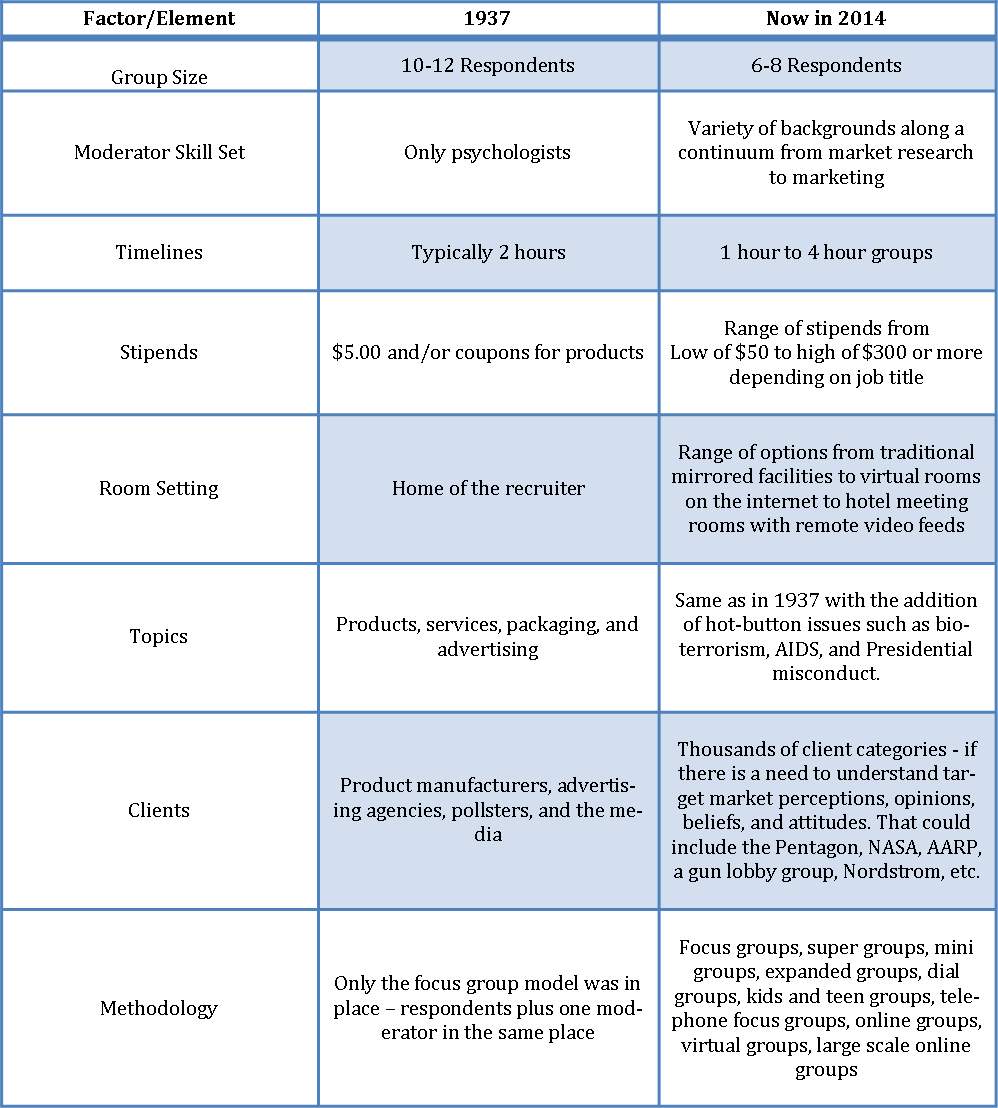Last week I read with some interest a Research Access article titled, “Are Focus Groups an Endangered Species?” As a seasoned, long time moderator, (having led more than 6,000 focus groups since 1978), a trainer of moderators, and an author, I am obviously quite alarmed at the idea that focus groups should be considered a dinosaur or endangered species.
I will wholeheartedly agree that all focus groups don’t work – they can go wrong for a number of reasons and they can be misused by observers. However, every industry has some flukes; the car industry continues to make cars even though some cars are lemons. They don’t stop making cars because some of them are not working as designed.
The first focus groups were held in America in 1937. In the three-quarters of a century since those first groups, focus groups have undergone a number of transformations as a research methodology as outlined in the chart below:
The qualitative research game changed a lot over the last seven decades and with the advent of additional technologies, even more adaptations will continue to be made in the qualitative arena.
Every now and then an article comes out in the press entitled: “Is God Dead?” and it goes on to report issues around the moral decay in the world. Those articles seldom report the growth of church membership in times of crisis, the role that religion plays in handling stress, or how religion provides millions with a moral center to face the challenges of a modern world. In the same way, one should be careful in reading a report on the “death of focus groups” as there is always another side to every story. I believe focus groups are, in fact, thriving and will continue to be applied to new situations over the coming years.
Many arguments against focus groups result from a misunderstanding of the limits of focus group qualitative research.
The argument of Inherent bias: I completely agree that there exists a bias in focus groups and that respondents may sway each other. But a skilled moderator knows how to set a context for avoiding bias. Many believe that the purpose of a focus group is to reach consensus…wrong, on every count. Focus groups with 8 participants, handled correctly, can achieve eight different points of view! There is never a reason to reach consensus in a focus group.
The very nature of focus groups is their subjective biases: convenience samples, paid respondents, and a fixed line of questions. So you may wonder, what’s the point? Because what counts in life, cannot be counted. Try to scale or measure love, patriotism, or brand loyalty. Try to count up a tally of what it means to own a dog or keep a Ford Mustang for 40 years. What counts, cannot be quantified and hearing that information trumps any biases that might be present.
The argument of Small sample sizes: There is never a reason to project the findings of 24, 36, or 48 people in focus groups to a universe and make a quantitative summary. The whole point of focus groups is to understand language, motivators, drivers, perceptions, opinions, beliefs, and attitudes which then can go into the development of quantitative surveys where projections can be made.
To call “small sample sizes” a fault of focus groups is to misunderstand the role of qualitative research. Quantitative research asks the questions, qualitative research questions the answers and provides insights that help decision-makers see the whole picture. Any client that would make a marketing decision based on 30 people is delusional and any moderator who supports that thinking is misguided at best and harmful at worst. Qualitative and quantitative research are like two sides of a hand. The quant is the back where the bones and sinews can be easily seen. The soft palm is qual research that possesses the ability to hold something with care. Both are critical to the whole picture of market research.
The argument of Time consuming and expensive to do it right. Yes, qualitative research takes time and is expensive – I have no argument with that premise. I also know that some of the finer things in life take time and cost a lot of money. A good example is aged whiskey. Moonshine can be made in one day and aged one night. But a good single malt scotch, aged 12 years or more, is smooth and satisfying. A lump of coal burns fast and hot, but that same lump pressed under tons of earth for centuries will turn into a diamond and is priceless. Qualitative research takes time but when you know how the target market thinks, you can sell more products and services. In the long run, a little more time with consumers at the front end of a process can send huge dividends to the bottom line.
Naomi writes more about her experiences as a Master Moderator in her book, Secrets of a Master Moderator.


